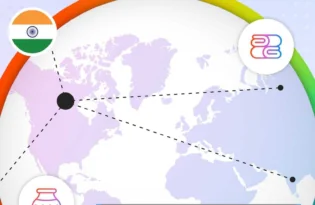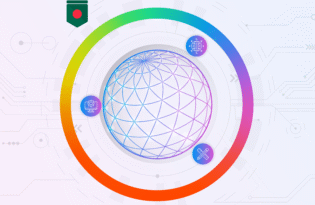Why the Philippines is Becoming a Global Health Technology Outsourcing Powerhouse
The Philippine healthcare services industry is thriving. The industry reported USD 4.2 billion in revenue from the healthcare sector in 2024 and employed 190,000 full-time employees during that period, with a 15% share in global GICs.

According to the Centre for International Trade Expositions and Missions (CITEM), the export promotion arm of the Philippine Department of Trade and Industry, the industry is expected to grow at a CAGR of 9% between 2022 and 2028.
The Southeast Asian country has been a popular choice for the US and the UK, presenting an appealing value proposition to foreign companies in healthcare, financial, IT, and other sectors. With over 400 diverse companies, the CITEM describes the Philippine Healthcare Information Management Services (HIMS) sector as a global hub for healthcare BPO services.
What Does HealthTech Outsourcing Include?
HIMS supports a spectrum of functions across revenue cycle management, pharmaceutical & life sciences, healthcare IT, and clinical support services.
| Revenue Cycle Management | Pharmaceutical & Life Sciences | Healthcare IT | Clinical Support Services |
|---|---|---|---|
| Medical Transcription ASRT Editing Eligibility & Enrollment Medical Coding Medical Billing Claims Processing/Management Risk Adjustment Billing & Reconciliation Workers Compensation Medical Records Review Membership & Benefits Management Case/Disease Management Care Management & Coordination | Benefit Design Management Retail Pharmacy Network Benefit Claims Testing Clinical Management Pharmacovigilance Regulatory Services Quality & Compliance Data Analytics for Pharma Case Management Clinical Trial Monitoring Data Mana | Mobile and Cloud Solutions Data Science and Analytics AI & Machine Learning for Healthcare Robotic Process Automation Blockchain for Healthcare Mobile Health Telemedicine EHR/EMR Application Development and Re-Architecture Application Maintenance and Support Independent Software Testing | Clinical Triage Patient Reminders Eligibility Verification Claim Status Inquiry Appointment & Follow-Ups Claims Reprocessing Medical Surveys Provider’s Visual Assistance Accounts Receivable Processing Patient Enrollment Data Entry/Processing Chart Abstraction Case Management Clinical Back Office Support |
(Source)
The Global Growth in Digital Health Services
According to MarketsandMarkets, a competitive intelligence and market research platform, the global health market is poised to grow at a 25% CAGR to USD 549.7 billion by 2028, from USD 180.2 billion in 2023. This robust growth is largely backed by:
- Surge in use of smartphones, tablets, and other personal devices
- Increasing focus on patient-centric solutions
- Prevalence of chronic diseases
- Growing elderly population
- Conducive healthcare policies
- Rising strategic collaborations
If we look at the market through the lens of technology, it primarily comprises four segments: mHealth, tele-healthcare, digital therapeutics, and health management solutions.
In 2022, tele-healthcare held the largest share, largely due to an increased demand fueled by Covid-19. Additionally, innovation, supportive policies, and the openness of customers and healthcare providers are some other factors that drove this demand.
Talking about the regional specifics of 2022, North America led the market. Europe and APAC followed next. This lead is largely due to the deployment of digital health solutions being more predominant in North America.
How Are the US and UK HealthTech Markets Shaping Up?
The Philippine health tech BPO is a common destination for US and UK companies. Decoding the future trajectory of these geographies will reveal potential business opportunities.
The US Healthcare Market
Estimated at USD 81.17 billion in 2023, the US digital health market is likely to grow at a CAGR of 19.5% from 2024 to 2030, per Grand View Research.
A conducive digital healthcare services environment and improved internet connectivity supporting remote healthcare services are expected to drive the market growth. Besides, increasing mobile and smartphone subscriptions will also be a key growth factor. Notably, the smartphone penetration grew from 83% in 2018 to 91% in 2023.
In 2023, the tele-healthcare segment reported the highest revenue share, primarily fueled by rising investments in tele-healthcare platforms post-COVID-19. The mHealth segment emerged as the second largest segment, largely due to the use of smartphones, mobile health applications, smartwatches and fitness trackers.
The UK Healthcare Market
According to IMARC, the UK digital health market size was valued at USD 12.8 billion in 2024 and is expected to grow at a CAGR of 12.11% from 2025 to 2033.
This growth is mainly due to the increasing adoption of personalized and remote healthcare services. Also, extensive government support and calculated efforts to shift healthcare delivery to a digital phase drive this sector.
The healthcare market comprises telehealth, medical wearables, electronic medical records (EMR) and electronic health records (EHR) systems, medical apps, healthcare analytics, and other segments. Of these, telehealth is the most dominant segment owing to its ability to provide quick and seamless healthcare services in urban and rural setups.
What Makes the Philippines a Popular Choice?
Several factors position the Philippines as a leading name in the healthcare BPO industry, including:
Operational Cost Savings
Lower labor costs typically translate into cost savings for foreign companies outsourcing to the Philippines. This allows them to maximize cost efficiency, enhance profitability, and allocate funds to other core business functions.
Skilled Talent Pool
Social Weather Stations states that 47% of Filipinos are competent in English in March 2023. Another survey, the 2024 Functional Literacy, Education, and Mass Media Survey, reveals that of every 10 Filipinos, 9 have basic literacy and 7 have functional literacy.
HIPAA and ISO Certifications
Many Philippine healthcare BPO companies comply with HIPAA, i.e., Health Insurance Portability and Accountability Act, signifying effective implementation of HIPAA’s privacy provisions and security standards. Also, the BPOs are typically committed to being ISO certified, indicating compliance with quality and safety standards.
What Does the Current ‘Wait and Watch’ Tariff Scenario Indicate?
After announcing tariff hikes on its business partners, the US paused its plan for most countries. Subsequently, the US-China trade war also went into a pause mode. However, recent developments suggest a potential increase in tariffs against the European Union.
Trade wars make imports more expensive, which in turn affects the overall budget of companies. Assuming an escalated trade war results in higher purchase costs for companies outsourcing to the Philippines, they may need to reevaluate their budgets to maintain profitability. This may also include cutting back on certain expenses, such as outsourcing.
On the other hand, if Philippine BPOs experience strained budgets in a high-tariff scenario, they may have to explore ways to achieve better operational and cost efficiencies or pass on increased costs to their clients. Time alone will give more clarity.
However, broadly speaking, smaller economies like the Philippines can leverage strategic opportunities arising from tariffs by implementing reforms focusing on offering reliable infrastructure, skilled labour, etc., positioning the country as a dependable tariff-resistant region.
Key Insights
Foreign healthcare businesses can explore the Philippine BPO industry to optimize their budgets and save on costs while leveraging the quality services of a professional workforce.
On the other hand, the Philippine BPO industry should focus on creating a diversified client base to eliminate dependency on any one geography. Besides, it is imperative to upskill for mitigating job displacement risk with the inevitable existence of AI.
Lastly, whether a service provider or receiver, businesses should focus on making their trade flow faster and easier to expand and streamline their operations. Cross-border business payment platforms such as Payoneer can simplify multi-currency management to make global transactions and international trade work better for businesses worldwide.
One such business to benefit immensely from Payoneer is Temark International, which earlier experienced limited business growth due to the unpredictability of traditional payment systems. Initially, the high transaction fees, slow payment processing, and a lack of personalized support posed challenges.
However, after integrating Payoneer into their operations, Temark International experienced a significant change. They continue to benefit from comparatively low transaction fees, faster cross-border payments, including international contractors, and dedicated assistance, which together contribute to their business growth.
Curious to know more about Payoneer’s role in empowering business expansions? Read the full success story here.
Related resources
Latest articles
-
How to hire employees in Ireland
Looking to hire employees in Ireland for your US company? Learn about employment in Ireland and how Payoneer Workforce Management makes it easy to hire in Ireland.
-
Planning to hire employees in Indonesia? Here’s a quick guide
Are you looking to hire employees in Indonesia? Learn about hiring in Indonesia and how Payoneer Workforce Management can help American companies hiring in Indonesia.
-
Planning to hire employees in France? Here’s a quick guide
Looking to hire employees in France for your U.S. company? Learn about employment in France and how Payoneer Workforce Management makes it simple to hire in France.
-
Planning to hire employees in Spain? Here’s a quick guide
Are you looking to hire employees in Spain? Learn about employment in Spain and how Payoneer Workforce Management can help American companies hiring in Spain.
-
How to hire employees in the Netherlands
Looking to hire employees in the Netherlands for your U.S. company? Learn about employment in the Netherlands and how Payoneer Workforce Management can help hire in the Netherlands.
-
How to hire employees in Australia
Looking to hire employees in Australia for your US company? Learn about employment in Australia and how Payoneer Workforce Management makes it easy to hire in Australia.
Disclaimer
Nothing herein should be construed as if Payoneer Inc. or its affiliates are soliciting or inviting any person outside the jurisdiction where it operates/is licensed to engage in payment services provided by Payoneer Inc. or its affiliates, unless permitted by applicable laws. Any products/services availability are subject to customer’s eligibility. Not all products/services are available in all jurisdictions in the same manner. Depending on your eligibility, you may be offered with the Corporate Purchasing Mastercard, issued by First Century Bank, N.A., under a license by Mastercard® and provided to you by Payoneer Inc., or the Payoneer Business Premium Debit Mastercard®, issued and provided from Ireland by Payoneer Europe Limited under a license by Mastercard. The Payoneer Business Premium Debit Mastercard® cannot be used at merchants or ATMs in Hong Kong or for HKD payments. If you are located in the EEA, all Payoneer Services will be provided to you by Payoneer Europe Limited, trading as Payoneer and regulated by the Central Bank of Ireland.
The information in this document is intended to be of a general nature and does not constitute legal advice. While we have endeavored to ensure that the information is up to date and correct, we make no representations or warranties of any kind, express or implied, about the completeness, accuracy, reliability or suitability of the information. In no event will we be liable for any loss or damage including without limitation, indirect or consequential loss or damage, or any loss or damage whatsoever incurred in connection with the information provided.













